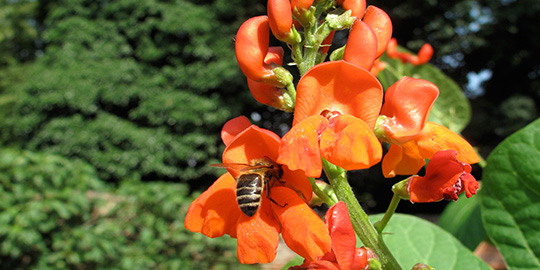
‘Beans and Bees’ Abbot’s Hall Walled Garden
July 2014
It has been beautiful in the garden this month if a little too hot at times.
The plants are alive with winged visitors as all the pollinating insects get busy collecting their summer harvest.
Here, the delightful orangey-red coloured flowers of the runner beans are captured being visited by our old friend the honey bee, Apis mellifera.
As well as runners we are also harvesting lots of our heritage varieties of french climbing beans from seed saved last year including the purple-podded ‘Kew Blue’, mottle-podded ‘Carter’s Polish’ and green ‘Blacksmith’s Bean’.
.jpg)
Also this month the outdoor cucumbers have been cropping at full-tilt. This year we have tried growing a few different heritage varieties to excite the eyes and taste buds. Among these are ‘Crystal Apple’ – a golf ball-sized crisp, sweet flavoured cucumber originating from Australia in the early 1900s. Alongside these lay ‘Boothby’s Blond’ an early productive cucumber with an oval shape and warty yellow skin.

Inside the greenhouse, our cordon-trained tomatoes have also been cropping well.
The potato-leaved ‘Brandywine’ variety dates back to 1885 and is regarded as an excellent beefsteak variety, bearing large, firm fruit with a pinkish flesh. Here, they are presented in a basket ready for sale on our Walled Garden Stall.

As part of our training on the Skills for the Future programme, Francis and I recently came back from a one day summer pruning course in Kent. It was lead by Mike Austen, a retired fruit farmer who has worked as a guide at the National Fruit Collection at Brogdale for 20 years. The course mainly focused on trained trees including espaliers, cordons and fans. Routine pruning often aims to stimulate growth, whereas with these trained forms summer pruning aims largely to restrict it, maintaining size, shape and form as well as encouraging the tree to produce new fruit buds for the following year. We have many different tree forms on display in the garden, our most recent addition being the cordon-trained apples which form the apple tunnel.
The main rule-of-thumb is to prune all-new laterals from the main stem to three leaves above the basal cluster (this is the lowest cluster of leaves on a shoot). Any side shoots that have formed of these laterals should be shortened to one leaf. We will be putting these newly gained pruning skills into action over the next month, so please feel free to come into the garden and ask any questions you may have on training the pretty and ornamental form of fruit trees.
Lucy Skellorn
Share this article


